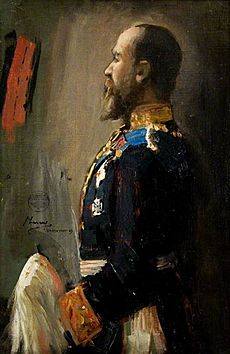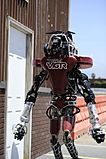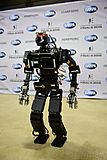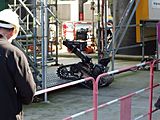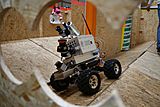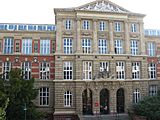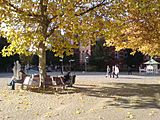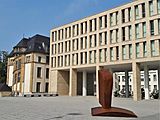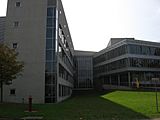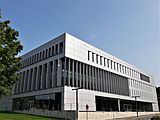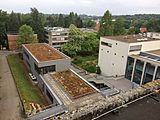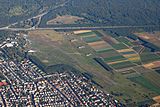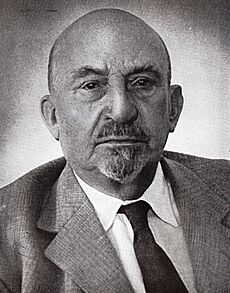Technische Universität Darmstadt facts for kids
|
Technische Universität Darmstadt
|
|

Athena, goddess of wisdom and strategy
|
|
|
Former names
|
Technische Hochschule Darmstadt |
|---|---|
| Type | Public |
| Established | 1877 |
| Budget | €454.3 million (2018) |
| President | Tanja Brühl |
|
Academic staff
|
2,593 |
|
Administrative staff
|
1,909 |
| Students | 24,293 |
| Location |
,
,
Germany
49°52′30″N 08°39′23″E / 49.87500°N 8.65639°E (inner city) 49°51′40″N 8°40′50″E / 49.86113°N 8.68056°E (Lichtwiese) |
| Campus | Urban/Suburban |
| Affiliations |
German Universities Excellence Initiative, TU9, CLUSTER, CESAER, T.I.M.E., EAIE, FGU, EIT, EUA, UNITE!, CAST
|
The Technical University of Darmstadt, often called TU Darmstadt, is a well-known research university in Darmstadt, Germany. It started in 1877 and was allowed to give out doctorates (the highest university degree) in 1899.
TU Darmstadt was a pioneer in many fields. In 1882, it was the first university in the world to create a special teaching position for electrical engineering. The next year, it opened the world's first department for electrical engineering and offered the first degree course in this field.
This university has introduced many new subjects in Germany. These include computer science, artificial intelligence, mechatronics, and political science.
TU Darmstadt is part of the Rhine-Main-Universities (RMU) group, along with two other universities. It is also a member of TU9, which is a group of the nine most important technical universities in Germany.
Many famous people have studied at TU Darmstadt. This includes Nobel Prize winners, successful business leaders, and politicians. As of September 2019, four Nobel laureates and three Wolf Prize in Physics winners are connected to the university.
Contents
History of TU Darmstadt
On October 10, 1877, Louis IV, Grand Duke of Hesse, changed the Polytechnische Schule (Polytechnic School) into the Technische Hochschule zu Darmstadt (Technical University of Darmstadt). This made it a full university. To get in, students now needed the Abitur, a special school certificate. In 1899, the university gained the right to award doctorates.
Early Days and Challenges
The university's journey began with smaller schools like the Höhere Gewerbeschule (Higher Trade School) in 1836. For a while, people wondered if the region could afford a technical university.
After 1877, student numbers were very low. There were even talks about closing the university in 1881-1882. But the local government and the university made a brave choice. They decided to create the world's first teaching position for electrical engineering. This led to the first Faculty of Electrical Engineering. This smart decision helped Darmstadt become a leader in this new field. More students came, and the idea of closing the university disappeared.
Growing as a University
In 1895, new buildings opened, including the 'Old Main Building'. Before World War I, the university added new subjects like paper making. In 1913, it even started a special teaching position for Aeronautics (the science of flight).
After World War I, the university needed to change its education system. The goal was to prepare engineers for important roles in society. In 1924, non-technical subjects were split into two departments: Mathematics and Natural Science, and Cultural Studies and Political Science. They also added more studies in Economics and new teaching positions in political science and sociology.
During World War II

Like other German universities, TU Darmstadt lost some of its scholars after 1933. For example, Gerhard Herzberg, who later won the Nobel Prize in Chemistry, had to leave in 1934.
On the night of September 11-12, 1944, most of Darmstadt and many university buildings were destroyed in a bombing. The university reopened in 1946. Even with damaged buildings, staff and students worked hard to continue their studies.
After World War II
In 1947, TU Darmstadt hosted the first International Congress on Engineering Education. People discussed the responsibility of scientists and engineers in society. They agreed to focus research and teaching on peaceful uses for humanity.
The university grew a lot in the 1960s. Since there wasn't much space in the city center, a second campus was built. This new campus, called 'Lichtwiese', opened in the late 1960s and early 1970s.
University Changes in the 1970s
In the 1970s, new laws changed how universities were run. TU Darmstadt got a new structure with departments and a unified administration.
Student numbers kept rising quickly in the mid-1970s. Even with many students, TU Darmstadt continued to innovate. It opened the School of Information Science in 1974 and the Department of Materials Science in 1989.
New Name for a New Era
By the late 1800s, the Technische Hochschule Darmstadt was already like a full university. To make its status clearer, especially to people in other countries, it changed its name to Technische Universität Darmstadt on October 1, 1997. This helped avoid confusion, as "Technische Hochschule" was sometimes misunderstood as "Technical High School" in English-speaking countries.
Becoming an Autonomous University
On January 1, 2005, TU Darmstadt became the first public university in Germany to manage itself. This meant it could handle its own budget, buildings, and even hire professors and decide their salaries. Before this, the state of Hessen did these things. This freedom also allows TU Darmstadt to invest in new business ideas.
A Pioneer University
TU Darmstadt has been a pioneer in many areas:
- In 1882, it was the first university in the world to create a special teaching position for electrical engineering.
- In 1883, it started the world's first degree course in electrical engineering.
- In 1913, it set up Germany's first teaching position for aviation and aircraft technology.
- In 1951, it created the first teaching position for scientific policy in Germany.
- In 1973, it established Germany's first teaching position for management control systems.
- The beginnings of computer science in Germany can be traced back to TU Darmstadt in 1928.
- In 1956, the first programming classes in Germany were offered here.
- In 1968, TU Darmstadt introduced Germany's first degree course in computer science.
- In 1975, it started the first degree course in business informatics.
- Artificial intelligence as a scientific field in Germany and Europe was started by Wolfgang Bibel, a professor at TU Darmstadt.
- In 1996, the first teaching position in Germany for renewable energies was set up here.
- In 2004, it became the first German university to be declared an autonomous university.
Academic Programs and Research
Student Population Growth
Here's how the number of students at TU Darmstadt has grown over time:
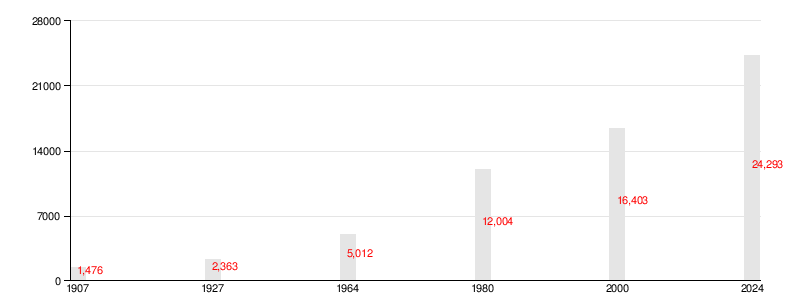
University Departments
TU Darmstadt has 13 academic departments. Most of them (ten) are in engineering, natural sciences, and mathematics. Three departments focus on social sciences and the humanities.
Here are some of the departments:
- Law and Economics
- History and Social Sciences
- Human Sciences
- Mathematics
- Physics
- Chemistry
- Biology
- Materials and Earth Sciences
- Civil and Environmental Engineering
- Architecture
- Mechanical Engineering
- Electrical Engineering and Information Technology
- Computer Science
Interdisciplinary Studies
The university offers five special study areas called Studienbereiche. These are interdisciplinary, meaning students take classes from different departments.
These areas include:
- Computational engineering
- Energy science and engineering
- Information systems engineering
- Mechanics
- Mechatronics
TU Darmstadt offers about 100 different courses of study. This includes bachelor's and master's degrees. They also train teachers for German vocational and secondary schools.
Main Research Areas
TU Darmstadt focuses on three main research areas:
- Energy and Environment (E+E)
- Information and Intelligence (I+I)
- Matter and Materials (M+M)
These areas help shape the university's reputation in the academic world.
Research Collaborations
TU Darmstadt works with many national and international research centers. Some of these include:
- GSI Helmholtz Centre for Heavy Ion Research (GSI)
- Fraunhofer Institute for Secure Information Technology SIT
- Fraunhofer Institute for Computer Graphics Research IGD
- European Space Operations Centre (ESOC)
- European Organisation for the Exploitation of Meteorological Satellites (EUMETSAT)
- German Research Centre for Artificial Intelligence
The university and GSI have a special partnership. They work together on the Facility for Antiproton and Ion Research (FAIR). The European Space Agency also has a research lab at TU Darmstadt, called ESA_LAB@TU Darmstadt. This was the first such lab at a German university.
In 2018, TU Darmstadt won a competition from the European Institute of Innovation and Technology (EIT). They are building an Institute for Manufacturing with 50 partners. These partners include big companies like Siemens and Volkswagen.
TU Darmstadt is also part of the German Universities Excellence Initiative. This program supports top research projects and graduate schools.
Working with Companies
TU Darmstadt has many research partnerships with companies. For example:
- PRORETA: A project with Continental AG to develop systems that help drivers avoid accidents.
- Merck Lab: A cooperation with Merck Group for research in chemistry and materials science.
- Intel Collaborative Research Institute for Secure Computing (ICRI-SC): A joint institute with Intel to study computer security.
- SAP Research: A partnership with the software company SAP SE for various research fields.
The university is also a member of CAST. This is the largest network for cybersecurity companies in German-speaking countries.
Strategic Partnerships
TU Darmstadt has special partnerships with companies like Merck Group, Deutsche Bahn, Continental AG, Robert Bosch GmbH, and Siemens.
They also have "Cooperative Labs." These are research labs run together with a partner. For example, the Merck Lab investigates new materials for electronics.
Since 2012, the DB Schenker Lab has been a "TU Darmstadt cooperation institute." It focuses on research in transport and logistics.
Innovation and Start-ups
TU Darmstadt has a center called HIGHEST. It helps students and researchers turn their ideas into new businesses. HIGHEST offers support for business plans, finding funding, and connecting with mentors and investors.
The university can even invest its own money in new start-ups. TU Darmstadt is seen as a role model for making start-up processes easy and fast. Since 2013, 95 new companies have started near TU Darmstadt.
High-Performance Computing
TU Darmstadt is one of the few German universities with a high-performance computer. It's called Lichtenberg, named after Georg Christoph Lichtenberg. It has a computing power of about 1 PetaFLOPS. For comparison, the fastest supercomputer in the world, Summit, has 148.6 PetaFLOPS (as of June 2019).
In 2017, TU Darmstadt received 15 million euros to expand Lichtenberg. The new version, Lichtenberg II, will be more than twice as powerful. It will be used for computational engineering.
TU Darmstadt is also part of the Competence Center for High Performance Computing in Hessen (HKHLR). This group includes other universities in Hessen that also have supercomputers.
Robotics Research
TU Darmstadt is known worldwide for its robot research.
- The search and rescue robot Hector, developed by the computer science department, won first place in the "Best in Class Autonomy" category at the RoboCup competition multiple times (2012-2015, 2018-2019). This means Hector was the most intelligent robot.
- In 2015, a team from TU Darmstadt competed in the DARPA Robotics Challenge with two robots, Johnny 05 and Florian.
- In 2017, the Argonaut robot, developed by a team led by Oskar von Stryk, won the ARGOS Challenge. This competition was for intelligent inspection robots on oil and gas platforms. Argonaut is the first fully autonomous robot for these tasks.
- In 2018, Hector won first place at the World Robot Summit in Tokyo in the Plant Disaster Prevention Challenge.
- The research team of Oskar von Stryk has been building the German Rescue Robotics Centre since 2018.
University Campuses
The university has 164 buildings and covers about 600 acres (2.4 km²). It is mainly located on three campuses: Inner City, Lichtwiese, and Botanical Garden. Some facilities are also in other parts of Darmstadt and in Griesheim, a nearby town.
Inner City Campus
This campus is right in the middle of Darmstadt. You can easily get there by tram and bus. Departments here include Electrical Engineering, History and Social Sciences, Human Sciences, Computer Science, Mathematics, Physics, and Law and Economics.
Campus Lichtwiese
The Lichtwiese campus is in the eastern part of Darmstadt. You can reach it by bus, tram, and train. Departments located here are Architecture, Civil Engineering and Geodesy, Chemistry, Mechanical Engineering, and Materials and Earth Sciences.
Botanical Garden Campus
The Botanical Garden of TU Darmstadt is close to the Lichtwiese Campus. The Department of Biology (FB10) is located here. There are also buildings for Materials and Earth Sciences and parts of the Darmstadt University of Applied Sciences.
Griesheim Airfield
Since 2005, TU Darmstadt has owned the August Euler Airfield. This is Germany's oldest airfield and is used for scientific research. It's named after its founder, August Euler, a pioneer in aviation. The airfield is used for testing things like driver assistance systems and automotive lighting. The university's wind tunnels are also nearby.
International Connections
About 18% of students at TU Darmstadt are from other countries. This is higher than the average for German universities. The university has partnerships with over 300 universities in 53 countries. This allows students to study abroad or come to Darmstadt. Some partner universities include University of California, Berkeley, Nanyang Technological University, and Seoul National University.
TU Darmstadt has been named a "European University" by the European Commission. It is part of the UNITE! alliance with six other European technical universities. This project aims to create a "trans-European campus" and encourage scientific cooperation.
The university offers many international master's programs taught in English. It also has many double degree programs.
Student Life
Activities and Sports
TU Darmstadt offers many sports courses. It has three sports halls, a sports stadium, a swimming pool, and a fitness studio. The university has won the title of "most athletic university in Germany" multiple times.
There are many student groups, like the Formula SAE Racing Team (DART) and the campus radio AudioMax. The annual konaktiva job fair connects students with future employers. This fair is organized by student volunteers.
Student Representation
Students at TU Darmstadt are represented by the students' parliament (Studierendenparlament, StuPa). This group is elected every year and chooses the General Students' Committee (Allgemeiner Studierendenausschuss, AStA). The AStA is like the student government. It helps students with university matters and offers social and economic advice.
The AStA also runs a café, a beer garden, a club, an office supply store, and a bicycle garage. Students can also take non-credit courses taught by other students.
Each department also has its own student council (Fachschaftsrat). These councils represent the students of their department. They participate in department meetings with professors and staff.
University Legends
Since the 1970s, there's a fun legend about a made-up student named Fritz Filter. He supposedly passed many exams in the Architecture Department and even graduated in 2004. He has even turned in more architecture theses since then!
Student Housing
In 2016, students in Darmstadt paid about 348 euros per month for rent, heat, and utilities. This made Darmstadt the ninth most expensive city for students in Germany at the time. This number was for students living alone and pursuing their first degree.
The state-run student affairs organization, Studierendenwerk Darmstadt, offers about 2600 beds in 10 student halls. These are for students from TU Darmstadt and the Darmstadt University of Applied Sciences.
Reputation and Rankings
| University rankings | ||||||||||
|---|---|---|---|---|---|---|---|---|---|---|
| Overall – Global & National | ||||||||||
|
||||||||||
In the QS World University Rankings of 2024, TU Darmstadt was ranked 246th globally. This made it the 15th best university in Germany. The Times Higher Education World University Rankings for 2024 placed it between 251st and 300th worldwide. In Germany, it ranked between 25th and 31st. The 2023 Academic Ranking of World Universities (ARWU) placed it between 401st and 500th globally, and between 25th and 31st nationally.
For many years, TU Darmstadt has been a top university for training future business leaders in Germany. It currently ranks number one. Nine board members of Germany's top companies (DAX listed) have studied there.
Graduates from TU Darmstadt earn the second-highest salaries among all public universities in Germany during their first two years of work.
In the latest Humboldt-Ranking, TU Darmstadt is ranked first in engineering.
According to the German Research Foundation (DFG) report from 2018, TU Darmstadt received the most funding of any German university for computer science research. It also received the fourth highest funding for engineering.
CSRankings shows that TU Darmstadt is a leading university in Europe for cryptography, IT security, and software engineering. For artificial intelligence, robotics, machine learning, and computer vision, it ranks second in Europe and first in Germany.
In the 2018 university ranking by the German business magazine Wirtschaftswoche, TU Darmstadt was considered the best university for business informatics. It also ranked 3rd for industrial engineering and 4th for mechanical and electrical engineering.
The Research Ranking of the Association for Information Systems placed TU Darmstadt 16th worldwide for business informatics. It was 3rd in Europe and 1st in Germany.
According to the Stepstone salary report for graduates 2017, TU Darmstadt graduates earn the highest salaries in engineering and information technology in Germany.
In the QS Graduate Employability Rankings 2019, TU Darmstadt ranked 3rd in Germany, 22nd in Europe, and 78th in the world.
Reuters also named TU Darmstadt among Europe's most innovative universities in 2019.
Notable People
Nobel Prize Winners
Here are some Nobel Prize winners who studied, taught, or researched at TU Darmstadt:
- Peter Grünberg, physicist and Nobel laureate in Physics (2007)
- Horst Ludwig Störmer, physicist and Nobel laureate in Physics (1988)
- Gerhard Herzberg, chemist, physicist and Nobel laureate in Chemistry (1971)
- Hermann Staudinger, chemist and Nobel laureate in Chemistry (1953)
Other Nobel laureates are also connected to the university:
- Gerhard Ertl, chemist and Nobel laureate in Chemistry (2007)
- K. Alex Müller, physicist and Nobel laureate in Physics (1987)
- Karl Ziegler, chemist and Nobel laureate in Chemistry (1963)
- Otto Hahn, chemist and Nobel laureate in Chemistry (1944)
- Carl Bosch, chemist, engineer and Nobel laureate in Chemistry (1931)
- Richard Willstätter, chemist and Nobel laureate in Chemistry (1915)
Business Leaders
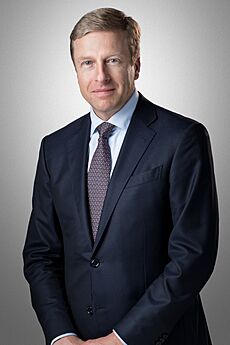
Many successful business people have come from TU Darmstadt:
- John Tu, founder of Kingston Technology
- Vikram Lal, founder of Eicher Motors
- Peter Schnell, founder of Software AG
- Enis Ersü, founder of ISRA VISION AG
- Péter Horváth, founder of Horváth & Partners
- Oliver Zipse, chairman of the board of management of BMW AG
- Christoph Franz, chairman of Hoffmann-La Roche AG
- Marcus Kuhnert, chief financial officer of Merck
- Kai Beckmann, CEO performance materials of Merck
- Tobias Meyer, board member of Deutsche Post AG
- Nicolai Setzer, executive board member of Continental AG
- Werner Steinmüller, executive board member of Deutsche Bank
Historical Figures
- Chaim Weizmann, the first president of Israel
- Karl Plagge, recognized for helping people during difficult times
- Jovanka Bončić-Katerinić, the first woman to get an engineering degree in Germany
- Günter Behnisch, architect of the Olympiastadion (Munich)
- Josef Ganz, automotive engineer and "father" of the original Volkswagen
Scientists and Researchers
- Georg Cantor, who created set theory
- Lothar Collatz, mathematician known for the still unsolved 3x + 1 problem
- Erwin Kreyszig, mathematician and author of the famous textbook "Advanced Engineering Mathematics"
- Carl Adam Petri, mathematician and inventor of the Petri nets
- Sigurd Hofmann, physicist and discoverer of chemical elements like darmstadtium
- Peter Armbruster, physicist and discoverer of several chemical elements
- Hans Busch, pioneer of electron optics and laid the basis for the electron microscope
- Wolfgang Bibel, one of the founders of artificial intelligence research in Germany and Europe
- Ottmar Edenhofer, lead author for reports by the Intergovernmental Panel on Climate Change, which won the Nobel Peace Prize
- Johann Dietrich Wörner, former Director General of the European Space Agency
- Kurt H. Debus, rocket scientist and first director of the Kennedy Space Center
- Robert Piloty, a pioneer of computer engineering and a founder of computer science courses in Germany
- Peter Mertens, one of the founders of business informatics courses in Germany
- Gerhard M. Sessler, inventor of the electret microphone
- Hermann Zapf, famous typeface designer (created fonts like Palatino and Optima)
- Eduard Zintl, chemist and discoverer of the Zintl phase
|
See also
 In Spanish: Universidad Técnica de Darmstadt para niños
In Spanish: Universidad Técnica de Darmstadt para niños



